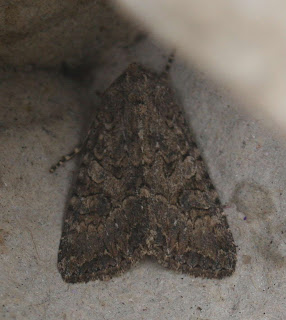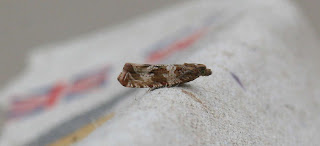Normal service resumed, with just 147 moths of 46 species. I had to dig deep into the micros to unearth something new - in the form of Stenolechia gemmella. If confirmed, this may be the second island record.
A member of family Gelechiidae, as far as I am aware the only previous record of Stenolechia gemmella was on 1st September 2007.
This is yet another species which exploits oaks as its larval food plant.
It is probably fair to say that the status of many micro moths in Jersey is not especially well-known. For example, I regularly trap specimens of this rather nondescript Gracillariid, which I believe is Caloptilia rufipennella - a species not previously recorded in the island.
Of course, there is always the strong possibility that my identification is wrong...
While giving some attention to micros, this perky little Gracillariid was just my second garden record of Gracillaria syringella, a species considered as common in Jersey.
The larvae of this 'leaf miner' no doubt feed on my lilac tree.
On the other hand, the rather splendid Celypha cespitana is a more or less constant feature in my catches.

Despite my opening comment, it's possible that I actually had a second new species during the night. I originally identified this Noctuid as a rather dark Nutmeg. However, I've just about managed to convince myself that it is, in fact, a Dusky Brocade - regarded as an uncommon resident in Jersey.


Fortunately, no great identification difficulties with these two moths. Shuttle-shaped Dart (left) is currently one of the most numerous moths - now in its second generation, after a brief mid-Summer absence. This is quite a distinctive specimen, rather darker than average, and with an unusual rufous cast to the outer forewing.
The exquisite Marbled Green (below) is considered common in Jersey, but I have trapped just a handful in the garden.
 The species rests on lichen-covered rocks and trees during the daytime, and the wing pattern provides effective camouflage on such surfaces.
The species rests on lichen-covered rocks and trees during the daytime, and the wing pattern provides effective camouflage on such surfaces.| Species | Count |
| Celypha cespitana | 7 |
| Agriphila tristella | 3 |
| Mother of Pearl | 1 |
| Black Arches | 6 |
| Riband Wave | 2 |
| Rosy Footman | 3 |
| Lesser Broad-bordered Yellow Underwing | 29 |
| Oak Hook-tip | 1 |
| Four-spotted Footman | 3 |
| Jersey Tiger | 3 |
| Vine's Rustic | 21 |
| Nutmeg | 4 |
| Dun-bar | 4 |
| Cabbage Moth | 6 |
| Shuttle-shaped Dart | 6 |
| Crescent Dart | 3 |
| Swallow Prominent | 1 |
| Flame Shoulder | 11 |
| Flame | 1 |
| Copper Underwing | 1 |
| Marbled Green | 1 |
| Dingy Footman | 2 |
| Common Rustic | 1 |
| Common Wainscot | 1 |
| Buff Ermine | 1 |
| Large Yellow Underwing | 2 |
| Silver Y | 1 |
| Willow Beauty | 1 |
| Heart and Club | 1 |
| Flounced Rustic | 1 |
| Bright-line Brown-eye | 1 |
| Cydia splendana | 1 |
| Setaceous Hebrew Character | 1 |
| Acrocercops brongniardella | 1 |
| Acleris forsskaleana | 2 |
| Burnished Brass | 1 |
| Knot Grass | 1 |
| Gypsy Moth | 1 |
| Chinese Character | 1 |
| White-shouldered House Moth | 1 |
| Blastobasis adustella | 3 |
| Stenolechia gemmella | 1 |
| Caloptilia rufipennella | 1 |
| Endothenia marginana | 1 |
| Gracillaria syringella | 1 |
| Dusky Brocade | 1 |






















